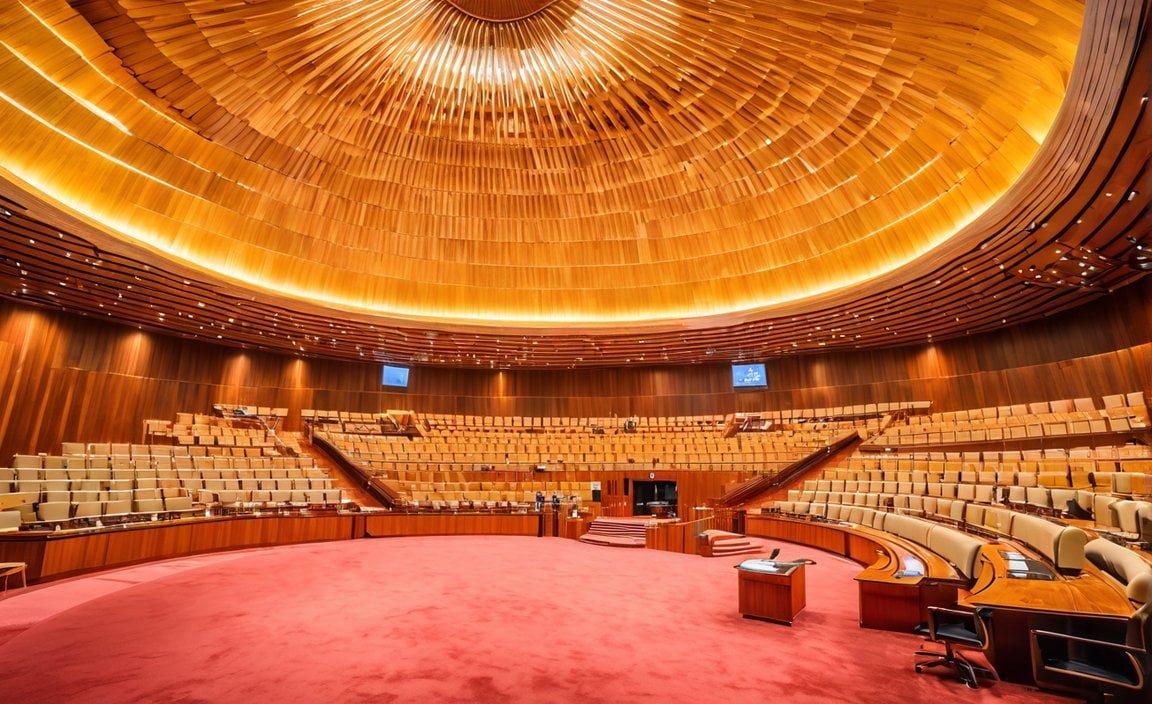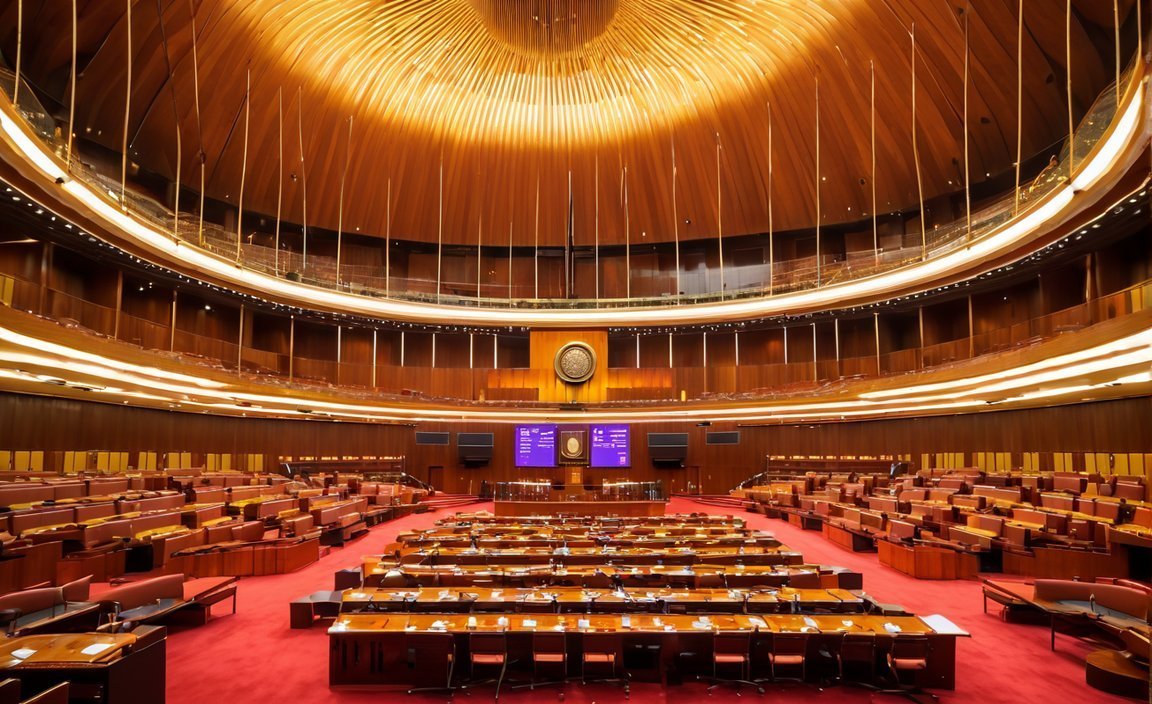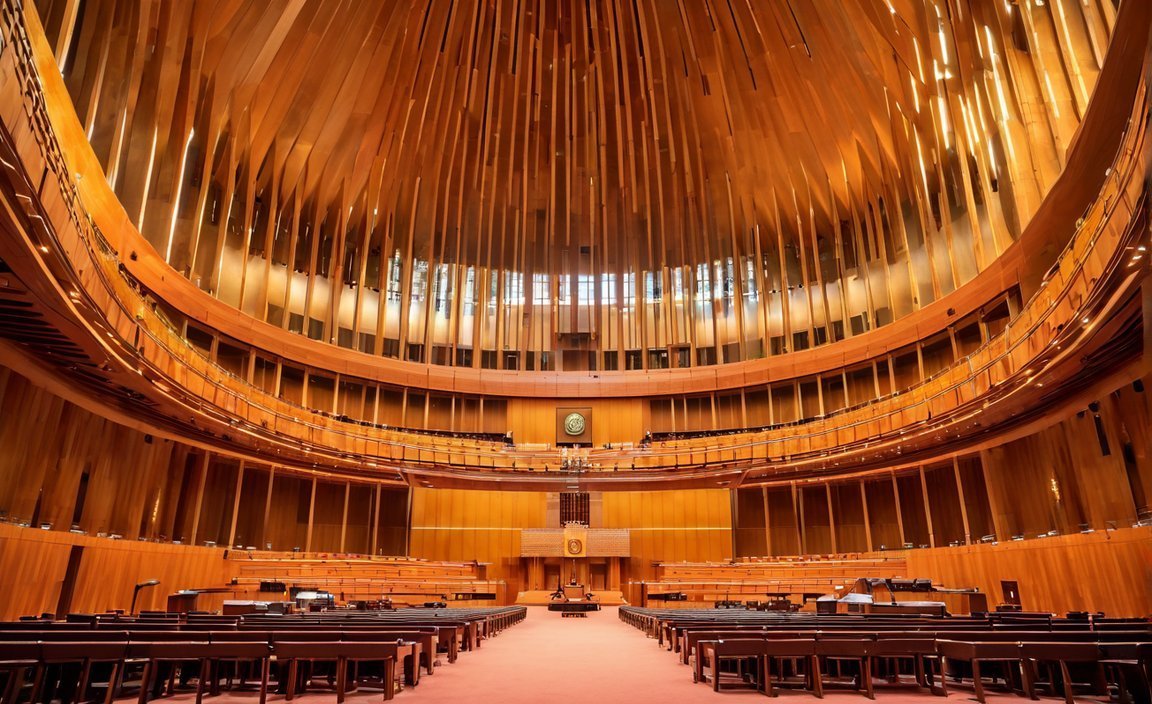Welcome to the fascinating world of Parliament House, where the wheels of democracy turn and shape the course of nations. In this article, we will delve into the depths of this iconic institution and uncover 10 intriguing facts that shed light on its inner workings. From its rich history to its awe-inspiring architecture, prepare to be captivated by the secrets and surprises that lie within the hallowed halls of Parliament House. So join us on this journey as we embark on an exploration of Parliament House: 10 Fascinating Facts.

Key Takeaways:
- The Houses of Parliament, also known as the Palace of Westminster, are owned by the monarch.
- The building is color-coded, with gold representing areas used by the monarch, red for the House of Lords, and green for the House of Commons.
- The Parliament considered leaving the Palace of Westminster during The Great Stink of 1858 due to the foul odor from the River Thames.
- The Palace of Westminster maintains traditional amenities while being a modern government building.
- The House of Commons was rebuilt after being severely damaged during World War II, thanks to funds donated by Commonwealth countries.
- The House of Commons has 650 seats, but there are 651 Members of Parliament due to the Speaker of the House not having a parliamentary seat.
- The Black Rod tradition, symbolizing the House of Lords’ independence and authority, dates back to the 14th century.
- Parliament House was designed to last 200 years, ensuring its durability.
- With 4,500 rooms, Parliament House provides ample space for parliamentary activities and functions.
- Parliament House in Canberra, Australia, welcomes approximately 1 million visitors annually, offering guided tours and attracting school groups.
10 Interesting Facts about Parliament House
The Parliament House, also known as the Palace of Westminster, is an iconic institution that holds significant historical and political significance. In this article, we will explore ten fascinating facts about Parliament House that showcase its unique characteristics and contributions to governance. So, let’s dive right in!
1. The Crown’s Ownership
Did you know that the Houses of Parliament are owned by the monarch? That’s right, the Crown has ownership rights over this historic building, which adds to its regal aura and symbolism.
2. The Color-Coded Hierarchy
The architecture of Parliament House incorporates a color-coded scheme to distinguish different areas. Gold is used for the parts used by the monarch, while red represents the House of Lords and green signifies the House of Commons. This hierarchy of colors reflects the relative importance of each element of Parliament.
3. The Great Stink of 1858
During the infamous Great Stink of 1858, the Parliament contemplated abandoning the Palace of Westminster due to the foul odor emanating from the River Thames. The strong smell caused significant discomfort to Parliament members, highlighting the challenges they faced in those times.
4. Preserving Tradition
Despite being a modern government building, the Palace of Westminster respects and maintains traditional amenities that have been a part of its legacy for centuries. This commitment to preserving historical traditions enriches the overall experience for visitors and instills a sense of continuity.
5. Rebuilding after World War II
World War II took a toll on the House of Commons, severely damaging it through bombings. However, in an inspiring gesture of solidarity, various Commonwealth countries, including Australia, provided funds to rebuild the House of Commons after the war.
6. The Speaker’s Seat
While the House of Commons has a total of 650 seats, there are actually 651 Members of Parliament (MPs). The intriguing discrepancy arises from the long-standing tradition of the Speaker of the House not occupying a parliamentary seat, symbolizing their impartial role.
7. The Black Rod Tradition
The Black Rod is a royal official responsible for ceremonial duties in the House of Lords. Dating back to the 14th century, this tradition symbolizes the House of Lords’ independence and authority, adding a touch of historic grandeur to the overall parliamentary proceedings.
8. A Building Designed to Last
Parliament House was designed with longevity in mind. It was constructed to have a lifespan of 200 years, ensuring its durability and ability to withstand the test of time. This architectural feat speaks to the careful planning and craftsmanship behind its construction.
9. The Maze of Rooms
Parliament House boasts an astounding 4,500 rooms, providing ample space for parliamentary activities and various functions. This vast collection of rooms encompasses offices, meeting spaces, libraries, and other essential areas that facilitate the smooth functioning of the parliamentary system.
10. A Popular Tourist Destination
Located in Canberra, Australia, Parliament House is a hub of political activity and also a popular tourist destination. Every year, it attracts approximately one million visitors who come to explore its halls, experience guided tours, and gain a deeper understanding of the inner workings of Australian governance.
As we wrap up, it’s clear that Parliament House is not just a seat of power but a repository of history, tradition, and political significance. The ten fascinating facts we’ve explored shed light on the unique aspects of this iconic institution, inviting us to appreciate its rich heritage that continues to shape the governance of nations.
Here are 10 interesting facts about various topics that will captivate your curiosity and make you want to know more!
Did you know that biomes are incredibly diverse ecosystems? Discover 10 fascinating facts about biomes here!
Explore the captivating world of condensation and learn 10 interesting facts about this natural phenomenon here!
Dive deep into the wonders of marine biology with 10 intriguing facts that will leave you in awe here!
Prepare to be amazed by the fascinating creatures of marine life! Check out 10 interesting facts about them here!
Uncover the secrets and history behind Parliament House Canberra with these 10 captivating facts here!
Discover the enchanting world of ponds and their incredible ecosystem with these 10 fascinating facts here!
Journey through the awe-inspiring savanna biome and learn 10 intriguing facts about this unique ecosystem here!
Dive beneath the waves and explore the captivating world of sea creatures with these 10 interesting facts here!
Immerse yourself in the wonders of sea life and discover 10 fascinating facts that will leave you amazed here!
Step into the mysterious taiga biome and uncover 10 captivating facts about this stunning ecosystem here!
Click on the links above and embark on an exciting journey of knowledge!
Unique Features and Architectural Highlights
The Parliament House is a fascinating institution that not only holds the power of governance but also showcases unique features and architectural highlights. Let’s delve into some intriguing facts about this iconic establishment that will leave you amazed.
1. A Historic Royal Ownership
Did you know that the Parliament House, also known as the Palace of Westminster, is owned by the monarch? This historical connection adds a touch of regality to the institution and reflects the deep-rooted ties between the British monarchy and the parliamentary system.
2. Color-coded Brilliance
Imagine walking through a building where each area is clearly distinguished by colors. Well, that’s how the Parliament House operates. The architectural design incorporates a color-coded scheme, making it easy for visitors and staff to identify different sections within the building. It’s like a vibrant and organized maze waiting to be explored.
3. A Stinky Past
In the year 1858, the Parliament House faced an olfactory challenge. The Great Stink, caused by the unsanitary conditions of the nearby River Thames, enveloped the building in a foul odor. The stench was so overpowering that there were discussions about abandoning the Palace of Westminster. Thankfully, measures were taken to address the issue, preserving Parliament House’s place in history.
4. Preserving Amenities from Yesteryears
While Parliament House stands as a modern institution, it still retains traditional amenities that harken back to days gone by. From the historic voting lobbies to the grand Westminster Hall, these preserved elements encapsulate the essence and heritage of the building.
5. A Commonwealth Collaboration
After the devastating bombing during World War II, the House of Commons needed reconstruction. The Commonwealth countries, including Australia, extended their support and provided funds for rebuilding the House of Commons. This act of solidarity showcases the international significance and shared values of parliamentary democracy.
6. Fewer Seats, More MPs
Here’s an interesting fact: the House of Commons has fewer seats than the number of Members of Parliament (MPs) it accommodates. It’s like a game of musical chairs, where MPs vie for a seat in the limited space available. This spatial constraint adds an element of uniqueness to the House of Commons.
7. The Authority of the Black Rod
The Parliament House is steeped in tradition and symbolism, and one such tradition is the Black Rod ceremony. The Black Rod, an official representing the House of Lords, symbolizes their independence and authority. This iconic ceremony serves as a reminder of the balance of power within the parliamentary system.
8. Modern Marvels in India
Not only does Parliament House capture the imagination in London, but it also has its own captivating features in India. The New Parliament Building in India boasts unique architectural highlights, such as a triangle shape design that optimizes space utilization and a massive built-up area of 20,886 square meters. These modern marvels showcase the fusion of tradition and contemporary design.
Key Takeaways:
- Parliament House, also known as the Palace of Westminster, is owned by the monarch.
- The architectural design incorporates a color-coded scheme to distinguish different areas.
- The foul odor from the Great Stink of 1858 almost led to the abandonment of the Palace of Westminster.
- Despite being modern, Parliament House retains traditional amenities.
- Commonwealth countries, including Australia, provided funds to rebuild the House of Commons after World War II.
- The House of Commons has fewer seats than the number of MPs it accommodates.
- The Black Rod tradition symbolizes the House of Lords’ independence and authority.
- The New Parliament Building in India features a triangle shape design for efficient space utilization and has a massive built-up area of 20,886 square meters.
Sources:
– Discover Walks – Top 10 Amazing Facts about the Houses of Parliament
– RealFynd – 10 Interesting Facts about the New Parliament of India: A Beacon of Modern …
Significance and Symbolism of the Building
Parliament House, also known as the Palace of Westminster, holds a deep significance and symbolism within its grand architecture and rich history. Let’s dive into 10 fascinating facts that illuminate the significance and symbolism of this iconic building.
1. A Color-Coded Hierarchy
The architectural design of Parliament House incorporates a meticulous color-coded scheme, creating a visual representation of the building’s hierarchy. Gold is reserved for areas used by the Monarch, symbolizing the highest level of authority. Red signifies the House of Lords, while green represents the House of Commons. This color hierarchy illustrates the importance and function of each area.
2. Preserving Centuries-Old Traditions
Despite being a modern government facility, Parliament House proudly preserves traditions that date back centuries. The Palace of Westminster, which houses the Parliament, upholds these long-standing practices, paying homage to the foundations upon which parliamentary systems were built. This adherence to tradition showcases the continuity and historical significance of this distinguished institution.
3. The Great Stink Drama
In the 19th century, Parliament faced a significant challenge known as The Great Stink. The foul odor emanating from the nearby River Thames was so pervasive that it caused discussions about abandoning the Palace of Westminster. The solution, however, was the construction of a complex sewage system to address the issue, ultimately saving the Parliament from relocation.
4. The Spirit of Resilience: World War II Bombing
During World War II, the House of Commons in the Palace of Westminster fell victim to bombings. However, in a display of unity and resilience, Commonwealth countries rallied together to rebuild the House of Commons. On May 10, 1941, the historic event took place, symbolizing the unwavering determination to preserve the democratic values represented by Parliament House.
5. A Living Monument of History
Parliament House stands as a living monument that encapsulates the rich tapestry of British history. From the ancient rituals and traditions to the scars of past conflicts, this iconic institution has witnessed the ebb and flow of momentous events. It serves as a tangible reminder of the democratic principles that have helped shape the nation.
6. Architectural Legacy
Designed to stand for over 200 years, Parliament House showcases exceptional architectural craftsmanship. Its imposing Gothic Revival style with intricate stonework, soaring towers, and stunning arches is a testament to the enduring legacy of Victorian architecture. This grandeur visually represents the significance of parliamentary democracy within the nation’s heritage.
7. A Hub of Democracy
With its 4,500 rooms, Parliament House serves as the bustling hub for parliamentary activities and functions. It buzzes with the energy of democracy as lawmakers, officials, and staff work tirelessly to shape the nation’s future. This expansive layout further emphasizes the prominence and complexity of the democratic process.
8. Welcoming Visitors
While Parliament House is a center of political power, it also plays host to thousands of visitors from around the world. Its grandeur and historical significance make it a must-visit attraction. The influx of tourists underscores the building’s role as a symbol of national identity and a promoter of global understanding.
9. The Symbolic Black Rod Ceremony
The House of Lords’ Black Rod tradition symbolizes the chamber’s independence and authority. The Black Rod, a key figure in parliamentary proceedings, knocks on the door of the House of Commons during the State Opening of Parliament. This symbolic act represents the separation and balance of power between the two houses.
10. A Beacon of Democracy
Parliament House stands as a shining beacon of democracy. Its significance lies not only in the function it performs but also in its symbolic representation of freedom, governance, and the power of the people. It serves as a constant reminder of the democratic ideals that form the backbone of societies worldwide.
Key Takeaways:
- Parliament House’s color-coded hierarchy reflects the importance of each area, with gold for the Monarch, red for the House of Lords, and green for the House of Commons.
- The building’s preservation of long-standing traditions showcases its respect for historical significance.
- The Great Stink of 1858 prompted the construction of a sewage system, preventing the abandonment of Parliament House.
- Commonwealth countries united to rebuild the House of Commons after bombings during World War II, illustrating resilience in the face of adversity.
- Parliament House serves as a living monument, representing the nation’s democratic principles and historical events.
- The architectural grandeur and expansive layout emphasize the significance and complexity of parliamentary democracy.
- Visitors from around the world flock to Parliament House, appreciating its historical and national significance.
- The Black Rod ceremony symbolizes the independence and authority of the House of Lords.
- Parliament House stands as a beacon of democracy, representing freedom, governance, and the power of the people.
Sources:
– Discover Walks
– Parliamentary Education Office
Interesting Stories and Anecdotes about Parliament House
Parliament House, also known as the Palace of Westminster, holds a rich history filled with intriguing stories and anecdotes. Let’s delve into 10 fascinating facts that shed light on this iconic institution.
1. A Royal Meeting Ground
The Houses of Parliament serve as the official meeting place for the Crown-in-Parliament, which includes the House of Lords and the House of Commons[^1^]. This makes them not only a hub for political activities but also an integral part of the monarchy.
2. A Colorful Display
A unique aspect of the Houses of Parliament is their color-coded scheme. The areas used by the monarch feature gold accents, symbolizing regal power. The House of Lords is adorned with shades of red, while the House of Commons is distinguished by vibrant green accents[^1^]. This clever design choice adds an aesthetic touch to the institution.
3. The Great Stink
In the 19th century, the River Thames emitted a foul odor that permeated the Palace of Westminster. The stench became so unbearable that Parliament contemplated abandoning the building during “The Great Stink of 1858″[^1^]. Fortunately, measures were taken to address this smelly issue, ensuring the preservation of this historic landmark.
4. A Unique Blend of Tradition and Modernity
While Parliament House serves as a modern center for governance, it is also dedicated to preserving time-honored traditions. This harmonious blend of old and new can be seen in the architectural design and the amenities it houses[^1^]. Visitors can witness the charm of historical customs while witnessing the functionality of a modern government.
5. The Space Challenge for MPs
The House of Commons is faced with an interesting spatial dilemma. Despite having a greater number of Members of Parliament (MPs) than seats, the chamber accommodates fewer seats[^1^]. This space scarcity highlights the challenges faced by MPs, making every seat a valuable commodity.
6. Rebuilding Bonds
The House of Commons suffered significant damage during World War II. However, in a display of international collaboration, the Commonwealth countries, including Australia, contributed to its rebuilding efforts[^1^]. This act of solidarity showcases the shared values upheld by democratic nations.
7. The Black Rod Tradition
One of Parliament’s longstanding traditions is the Black Rod ceremony. During State Opening or when the House of Commons is summoned, a senior officer of the House of Lords known as the Black Rod attends to these important events[^1^]. This ceremonial ritual symbolizes the connection between the House of Lords and the House of Commons.
8. An Icon of Design and Durability
Parliament House boasts an iconic design that is meant to last for 200 years. With its 4,500 rooms and a monumental size, it stands as a testament to architectural excellence[^2^]. Its durability and grandeur make Parliament House an impressive and enduring structure.
9. Flying High with Pride
The Parliament House proudly displays an 81-meter high stainless steel flagpole, flying a remarkable 12.8 by 6.4-meter flag[^2^]. This towering symbol signifies the country’s identity and serves as a reminder of the values upheld within its walls.
10. Unlocking the Secrets of Parliament House
To delve deeper into the history, design, and traditions of Parliament House, curious visitors can explore various sources such as Discover Walks and the Parliamentary Education Office[^1^][^2^]. These resources provide additional information, further enriching the experience of discovering Parliament House.
Key Takeaways:
- The Houses of Parliament serve as a meeting place for the Crown-in-Parliament, housing the House of Lords and the House of Commons.
- Parliament House features a color-coded scheme with gold, red, and green accents to distinguish different areas.
- The foul odor caused by the River Thames, known as “The Great Stink of 1858,” threatened the continuation of Parliament House until measures were taken to mitigate the issue.
- Parliament House blends modernity with tradition, showcasing historical customs alongside a functional government.
- The House of Commons faces a space challenge, accommodating fewer seats than the number of MPs it hosts.
- Commonwealth countries, including Australia, contributed to the rebuilding of the House of Commons after World War II, demonstrating international solidarity.
- The Black Rod tradition symbolizes the connection between the House of Lords and the House of Commons during ceremonial events.
- Parliament House is an iconic architectural achievement designed to last 200 years, featuring 4,500 rooms.
- A towering stainless steel flagpole proudly displays a large flag, symbolizing the nation’s identity.
- Additional sources, such as Discover Walks and the Parliamentary Education Office, offer more detailed insights into Parliament House’s history, design, and traditions.
Sources:
[^1^]: Discover Walks – Top 10 Amazing Facts about the Houses of Parliament
[^2^]: Parliament House – Parliamentary Education Office – Parliament House

FAQ
Q1: Who owns the Houses of Parliament?
A1: The Houses of Parliament, also known as the Palace of Westminster, are owned by the monarch.
Q2: Why are different colors used in the Houses of Parliament?
A2: The building is color-coded to distinguish different areas. Gold is used in the parts used by the monarch, red for the House of Lords, and green for the House of Commons.
Q3: Why was the Parliament considering abandoning the Palace of Westminster in 1858?
A3: The Parliament considered abandoning the Palace of Westminster due to the foul odor emanating from the River Thames during “The Great Stink” in 1858.
Q4: How many rooms does Parliament House have?
A4: Parliament House boasts an impressive 4,500 rooms, providing ample space for parliamentary activities and functions.
Q5: How many visitors does Parliament House attract annually?
A5: Parliament House in Canberra, Australia, attracts approximately 1 million visitors every year, offering guided tours and often visited by school groups.
- SYBAU See You Baby Meaning: Gen Z Slang Evolves - July 1, 2025
- Unlock Your Inner Youth: Lifestyle Secrets for a Vibrant Life - July 1, 2025
- Decode SYBAU Meaning: Gen Z Slang Explained - July 1, 2025






